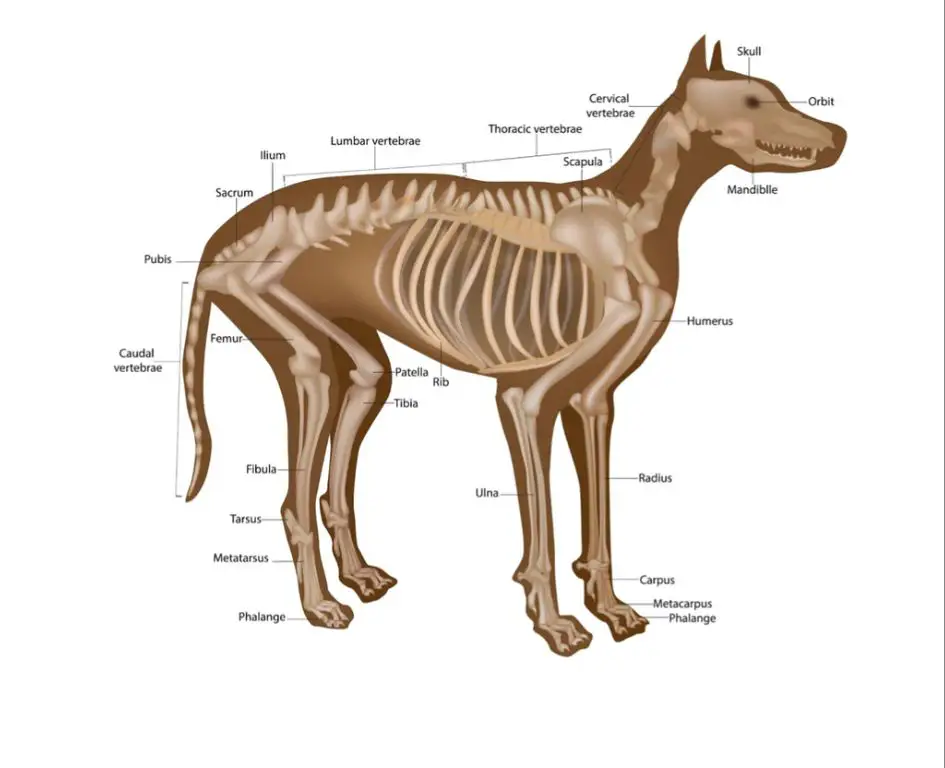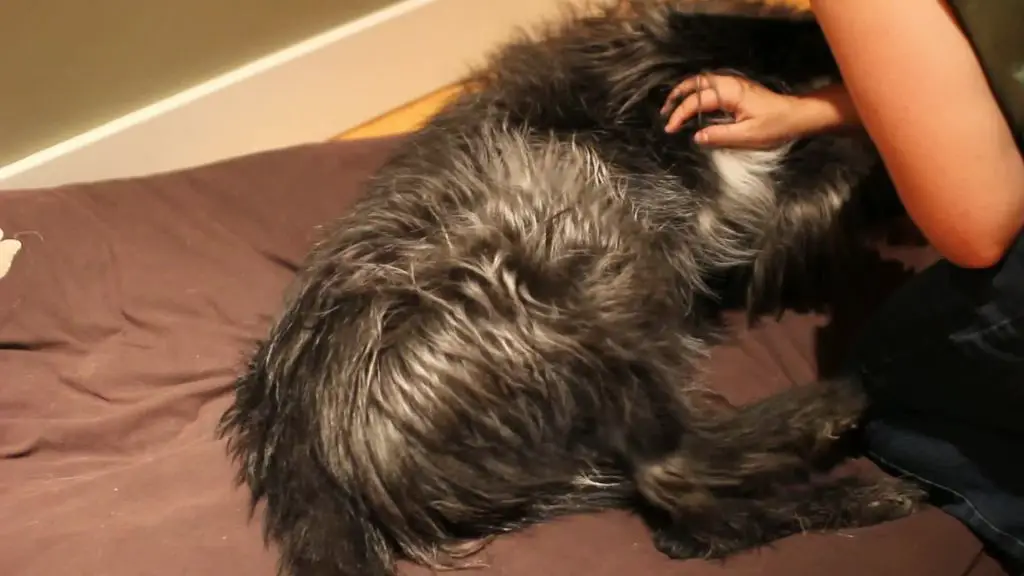Introduction
Many dog owners have experienced the strange phenomenon of the “dog kick” – when a dog’s hind leg suddenly kicks in response to being scratched or pet near the hips or base of the tail. This involuntary kicking motion is caused by stimulation of a particular spot known as the “scratch reflex” area. When this spot on a dog’s back is scratched or touched, it triggers nerves that induce the kicking movement.
The kicking reflex ultimately stems from an anatomical feature known as the perineal gland, which is located near the anus and secretes pheromones. When pressure is applied near this gland, it stimulates nerves that cause the dog’s hind leg to jerk upwards involuntarily. While the kicking reflex may seem unusual, it serves an important biological purpose for dogs.
Anatomy
The “kick spot” refers to a specific anatomical region on a dog’s belly known as the ventrolateral abdominal area. This is located on the side of a dog’s abdomen, above the hind legs. There are nerve endings in this region that connect to the dog’s spinal cord and hind legs. When stimulated, these nerves can trigger a reflex that causes the dog’s hind leg to kick involuntarily.

The nerves that run to this area originate in the dog’s lower spinal cord, which contains the motor neurons that control the hind legs. These nerves branch out from the spinal cord and travel down either side of the abdomen. The nerves penetrate the abdominal wall and connect with sensory receptors in the skin and tissue of the ventrolateral area.
When pressure is applied to this “sweet spot,” it stimulates the sensory receptors, which send signals to the motor neurons controlling the hind legs. This triggers a reflex arc that causes the rapid kicking motion, without any conscious control from the dog.
Origins
The canine “kick spot”, also known as the dog’s flank, has evolutionary origins related to communication and social behavior. Dogs descended from wolves, which are pack animals with complex social structures. Wolves have scent glands in their flanks that produce pheromones used for chemical communication and marking territory. When wolves greet each other, they sniff each other’s scent glands to gather social and reproductive information.
As dogs were domesticated by humans over thousands of years, certain wolf behaviors and traits were selectively bred. The flank scent glands remained, though they became less developed in dogs compared to wolves. The flank area is still sensitive and stimulating it causes a reflexive kicking motion. This reflects the evolutionary origins of the kick spot as a mechanism for spreading scent and conveying social information.

Function
The kicking reflex serves an important purpose for dogs. This involuntary reflex is linked to a specific spot on a dog’s belly called the “sweet spot.” When this area is scratched or touched, it stimulates nerves under the dog’s skin that cause their hind leg to start kicking.
This reflex originates in the spinal cord and activates nerves that trigger the leg muscles to contract rhythmically, creating the kicking motion. It provides the following key benefits for dogs:
- Scratching the sweet spot provides pleasurable sensations for the dog.
- The kicking motion helps dogs stretch their hind legs and back muscles, promoting flexibility.
- It’s a way for dogs to scratch their own bellies, providing relief from itches.
- The stimulation may release feel-good endorphins in the dog’s brain.
- It strengthens the bond between dogs and their owners through positive touch.
So while the kicking reflex may seem silly, it serves valuable physical and psychological purposes for canines when their sweet spot receives the right stimulation.
Stimulation
One of the most common triggers for the kicking reflex in dogs is stimulation of the scruff area. The scruff is the loose skin on the back of a dog’s neck. When this area is lightly scratched or touched, it can activate nerves that cause the scratch reflex and make the dog’s hind leg start kicking involuntarily.

This is because the nerves that serve the scruff connect to the same part of the spinal cord that controls the hind legs. The scratch reflex originates in the dog’s spinal cord, not their brain. So when those nerves are stimulated, it activates the spinal reflex arc which causes the scratching motion, even if the brain isn’t telling it to.
In puppies, even lightly restraining them by the scruff can trigger kicking. Some dogs are more sensitive in this area throughout adulthood as well. But the level of stimulation needed to trigger kicking often lessens as the dog matures.
Touching anywhere along the dog’s back can also elicit the scratch reflex in some sensitive dogs. Lightly brushing along the sides, hips, chest, stomach, and hindquarters can trigger kicking if the nerves are easily excitable.
However, the scruff remains the most common place that will instantly make dogs start scratching when touched. That’s why pet owners often gently grasp this area when trimming nails or giving medication to keep dogs from squirming.
Breed Differences
The scratch reflex can vary significantly across dog breeds. Certain breeds tend to have a stronger reflex than others. For example, Labrador retrievers are known for having an especially sensitive scratch reflex spot compared to other breeds. On the other hand, some short-legged breeds like dachshunds and corgis seem to have a weaker reflex. There are a few potential reasons for these breed differences.

One factor is the amount of fur and skin around the scratch spot. Dogs with long, thick fur tend to be less sensitive since the fur helps cushion the area. Dogs with short fur and thin skin tend to be more sensitive. The density of nerve endings in the skin also plays a role. Some genetic lines may have more nerve endings clustered around the spot.
Additionally, breeds that were historically used for hunting and retrieving tend to have a more pronounced scratch reflex. This aided their ability to kick their back legs and splash in the water while swimming after prey. Non-sporting dogs that did not have a job to do seem to have a less intense reflex on average.
While the scratch reflex exists in all dogs, its exact sensitivity and intensity can differ quite a bit between breeds. Pay attention to your own dog’s specific sensitivities, especially if they are a breed known for having a hyper-stimulated reflex. Never intentionally try to trigger the reflex, but be cautious of the area during regular petting and grooming.
Risks
Overstimulating a dog’s kick spot can be dangerous and should be avoided. This sensitive area on a dog’s back near their hind legs triggers the scratch reflex, causing their leg to kick involuntarily. Excessive scratching or rubbing of this area can overstimulate the nerve endings connected to this reflex.
Overstimulation of the scratch reflex through the kick spot can lead to muscle spasms, cramps, and strained tendons in the leg. The repeated kicking motion from excessive stimulation can also cause joint issues and even neurological problems over time. Some dogs may even become reactive or nip at owners who overstimulate this area.
Additionally, obsessively targeting a dog’s kick spot can create a sensitive fixation on the area. This can lead to anxiety, agitation, or even aggression in some dogs if the area is touched. It’s best to only occasionally stimulate a dog’s kick spot during calm petting and moderate scratching sessions.
Dog owners should refrain from tapping, hitting, or aggressively rubbing the kick spot area. Gentle scratching in moderation during grooming or petting is sufficient to get a cute kick reaction without endangering the dog’s health. Monitoring the dog’s comfort level and avoiding overstimulation is key to safe enjoyment of this reflex.
Treating Excessive Kicking
If your dog’s scratch reflex is causing excessive kicking that risks injury, there are ways to help manage the behavior:
-
Trim the hair around the scratch reflex area to reduce stimulation.
-
Avoid scratching or touching the area unnecessarily.
-
Use a TENS (transcutaneous electrical nerve stimulation) unit or vibration device on the area to desensitize it.
-
Try anti-inflammatory medications or neuropathy medications if recommended by your veterinarian.
-
Use an Elizabethan collar to prevent your dog from reaching the area and scratching it.
-
Consider surgery to denervate the scratch reflex on one side if it is excessive. This prevents nerve transmission to the area.
With training and management, you can help control excessive kicking in dogs when the scratch reflex is stimulated. Talk to your veterinarian if your dog’s scratch response becomes problematic.
Prevention
There are several ways dog owners can avoid triggering the scratch reflex:
-
Keep nails trimmed short to minimize scratching irritation.
-
Brush regularly to remove loose hairs that can get caught under nails and irritate skin.
-
Use a scratch board or pad to provide a designated scratching spot.
-
Trim the fur between toe pads to prevent matts that can irritate.
-
Inspect and clean feet regularly to keep free of debris.
-
Use paw balms or moisturizers if dog has dry, cracked paw pads.
-
Avoid letting dog dig excessively, which can irritate nails and skin.
-
Redirect scratching to more appropriate objects or locations.
-
Consider protective footwear if excessive scratching occurs outdoors.
With some awareness and proactive care, dog owners can help prevent triggering the scratch reflex in dogs.
Conclusion
The kicking reflex seen in dogs when you scratch a certain spot on their backs or bellies is something all dog owners are familiar with. While a seemingly simple behavior, understanding the cause and function of this reflex provides important insight. The area, called the scruff, contains nerve endings that stimulate nerves running to the spinal cord and then back to the rear leg muscles, triggering involuntary kicking.
It’s important for owners to be familiar with this reflex so they know what causes the behavior. The reflex serves an important purpose, helping young puppies stimulate breathing and blood flow and enabling mother dogs to move their pups. As dogs mature, the strength of the reflex lessens but can still be stimulated. Being gentle when scratching this area and discouraging children from rough stimulation can help avoid any risk of injury.
Overall, the kicking reflex is a fun quirk in many dogs that reveals the amazing integration of their nervous systems. With proper care and handling, owners can enjoy this amusing behavior while keeping their pets safe and healthy.